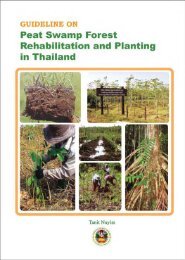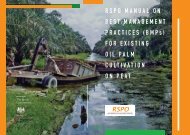Untitled - Peat Portal
Untitled - Peat Portal
Untitled - Peat Portal
You also want an ePaper? Increase the reach of your titles
YUMPU automatically turns print PDFs into web optimized ePapers that Google loves.
DEVELOPMENT OF FINANCING AND INCENTIVES OPTIONSFOR SUSTAINABLE MANAGEMENT OF PEATLAND FORESTS IN SOUTHEAST ASIA8The voluntary approach tends to work best where the industry is well organised, with relativelyfew large firms or producer groups with the necessary resources and existing market share toafford the adoption of such measures. The approach has been relatively successfully deployed in theconservation of peatlands in the UK and Ireland where they are under threat from exploitation forhorticultural and gardening use (Box 1).3.1.2 FISCAL INCENTIVESFiscal incentives refer to economic incentives that rely on direct government action to alter thefinancial performance of specified activities of targeted economic agents. These can be individuals,companies and other institutions that are part of the fiscal regime for that country and can takethe form of a subsidy payment or taxation. A typical approach would be where charges and taxesare levied on businesses for environmental reasons. Green taxes can be effective if they increase thecost of pollution to the point where an industry alters its production process to avoid the charge.Sometimes fiscal incentives require new legislation, but often they are introduced by adaptingexisting policy instruments through for example, altering taxation rates and allowances for activitiesthat benefit the environment or adding environmental conditions into existing subsidy payments.3.1.2.1 TaxationThe Polluter Pays Principle (PPP) ensures that the economic agent responsible for producing pollutionpays for the damage done to the environment. In essence it seeks to shift the responsibility dealing withwaste from the state (and thus, the taxpayer and society at large) to the entities producing it. In effect, itinternalises the cost of pollution and waste disposal into the cost of the product, theoretically meaningthat the producers will improve the waste profile of their products, thus decreasing waste and increasingpossibilities for reuse and recycling.PPP is widely recognised internationally and is promoted by the Organisation for EconomicCooperation and Development (OECD) and member nations of the European Union (EU) and itspecifically mentioned in Principle 16 of the Rio Declaration on Environment and Development.Often referred to as a green tax or an eco-tax, PPP underpins environmental policy in many countries,for example, with regard to fuel consumption. Other examples include the U.S. Superfund law thatrequires polluters to pay for clean up of hazardous waste sites, when the polluters can be identified.Typically, charges or taxes are prices paid for discharges of pollutants to the environment, based onthe quantity and/or quality of the pollutant(s) are the most effective, with the charges levied directlyon the quantity of pollution in the form of an emissions tax or charge. Product charges can occur atdifferent usage points, either as they are manufactured, consumed, or disposed of.An input tax refers to a tax that is applied for inputs to processes that lead to environmental damage.There has to be a clear identifiable scientific link between the input and the damage. For example, a taxon fertilisers used in farming has been suggested where its use have been shown to lead to pollutionthrough eutrophication (Pearce and Koundouri, 2003). Faced with such a tax the farmer would havean incentive to reduce their use of fertilisers to improve their profitability (but this would depend onthe level of tax applied and the effect on crop production). To avoid severe financial pressure on farmincome, revenues raised could be returned to the farmer to maintain overall profitability, for example,through subsidies for providing additional environmental benefits (e.g. wildlife habitat) or for nonpollutingfertiliser regimes.Box 1: Deployment of Voluntary Approach to Conserve <strong>Peat</strong>lands in UK and Ireland<strong>Peat</strong> bogs are increasingly recognised as valuable habitats forwildlife and important stores of carbon.The UK has lost 94% of its lowland raised peat bogs since thebeginning of the 19th century due to drainage, colonisationby scrub, forestry plantations, conversion to agriculture,development and peat extraction.The greatest current threat is peat extraction for use inhorticulture. Current demand is 3.4 million cubic meters peryear, and two thirds of this is used by amateur gardenerssourced from bogs in the UK and Republic of Ireland.Environmentalists, government and horticultural businessesin the UK now recognise the environmental consequencesof using peat in horticulture, and the industry is beingencouraged to turn to more sustainable raw materials. Initially,the campaign encountered deeply-ingrained practices sothat the shift in behaviour was slow.To encourage adoption the UK Government introducedtargets for peat replacement which have helped stimulatethe industry to develop suitable alternatives. The majorgardening retailers have included peat replacement targetsin their environmental codes of practice, and these arebeing met through incremental peat dilution with alternativematerials such as green compost, coir dust, and processedtimber by-products.Some organisations, such as the National Trust, have madea commitment to phase out the use of peat entirely as thisis consistent with their pro-environmental profile. A numberof garden suppliers now market peat which is not harvestedfrom protected areas.However, some peat comes from non-protected sites, andit is anticipated that stronger legislation will be introducedto protect the peatland resource throughout the EuropeCommunity in light of their increasing value for biodiversityconservation sites and for carbon.Source: Mires and <strong>Peat</strong>, Volume 3 (2008), Article 08, http://www.mires-and-peat.net/, ISSN 1819-754XDEVELOPMENT OF FINANCING AND INCENTIVES OPTIONSFOR SUSTAINABLE MANAGEMENT OF PEATLAND FORESTS IN SOUTHEAST ASIA9





